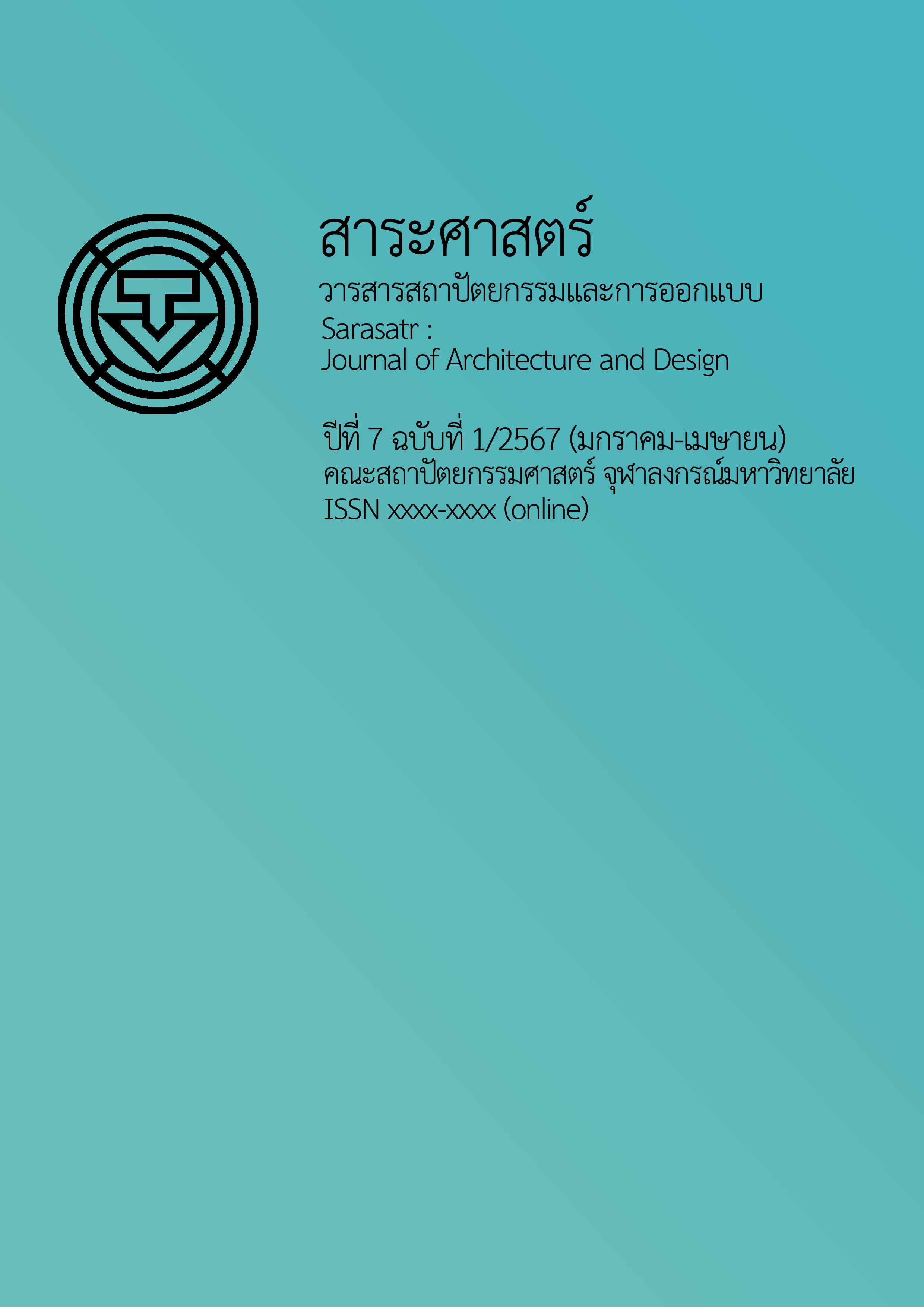สถาปัตยกรรมศิลปะการต่อสู้ของญี่ปุ่น
Main Article Content
บทคัดย่อ
บทความวิจัยนี้ คือการศึกษาสถาปัตยกรรมในเชิงปรากฏการณ์วิทยาเพื่อทำความเข้าใจสถาปัตยกรรมแห่งศิลปะการต่อสู้ หรือเรียกว่า ‘บูโด’ (Budo) ของญี่ปุ่น วัตถุประสงค์ คือการนำเสนอกระบวนการสร้างความเป็นไปได้ของไดอะแกรมและบรรยากาศทางสถาปัตยกรรมในรูปแบบสามมิติ ข้อมูลปฐมภูมิในบทความวิจัยนี้คือ 1) การเขียนแบบผังพื้นในเชิงวิเคราะห์สถาปัตยกรรมบูโดสิบสองแบบ ที่มาจากวารสารและรายงานต่าง ๆ ผังพื้นเหล่านี้รวมถึงปราสาทชูริ (สร้าง ค.ศ. 1322) นิคโกะโทโชกุ (สร้าง ค.ศ. 1617) วัดเอโชจิ (สร้าง ค.ศ. 1636) ได นิปปอน บูโดกัน (สร้าง ค.ศ. 1895) เกียวโต บูโดกัน (สร้าง ค.ศ. 1899) โตโชกุ บูโดคุเด็น (สร้าง ค.ศ. 1915) จนถึงไซโกคุ (สร้าง ค.ศ. 2017) 2) บทสัมภาษณ์ผู้เชี่ยวชาญและนักศึกษาในสมาคมศิลปะการต่อสู้ของญี่ปุ่นแห่งประเทศไทย สมาคมศิลปะการต่อสู้แห่งประเทศไทยต้องการสถาปัตยกรรมที่ใช้งานได้สำหรับการฝึกซ้อม การจัดการแข่งขัน และเหนือสิ่งอื่นใดคือ การแสดงจิตวิญญาณของบูโด กล่าวคือ ศิลปะการต่อสู้จากนักรบซามูไร
กรอบทฤษฎีของบทความวิจัยนี้เริ่มต้นจากหนังสือชื่อ The Origin of the Work of Art (2002) ของนักปรัชญาชาวเยอรมัน มาร์ติน ไฮเดกเกอร์ (Martin Heidegger) และ In Praise of Shadows ที่ประพันธ์โดย จุนอิจิโร ทานิซากิ (Junichiro Tanizaki) การทบทวนวรรณกรรมแบ่งออกเป็นสองส่วน ส่วนแรกครอบคลุมบริบททางประวัติศาสตร์ของสถาปัตยกรรมบูโด ส่วนที่สองเกี่ยวข้องกับปรากฏการณ์วิทยาในสถาปัตยกรรมญี่ปุ่นและแนวคิดในการออกแบบที่ 'ความมืดและความลึกลับ' มีบทบาทในการบรรลุความงามอันสมบูรณ์แบบ เรียกกันว่า ‘ยูเก็น’ (Yugen)
ผลลัพธ์ของการวิจัยนี้มีสองประเด็น ประเด็นที่หนึ่ง คือการนำเสนอกระบวนการออกแบบผ่านการแปลการเคลื่อนไหวของร่างกายบูโดให้เป็นแผนภาพทางสถาปัตยกรรม เพื่อสร้างแนวทางในการสร้างแผนภาพทางสถาปัตยกรรมที่สื่อถึงจิตวิญญาณของบูโดซึ่งประกอบด้วย ซิน (mind) กี (skill) ไท (body) งานวิจัยนี้เป็นการบันทึกภาพถ่ายแสดงกระบวนท่าไซเอนจิ้น ของบูโดอย่างมีระเบียบแบบแผน ประเด็นที่สอง คือการนำเสนอความเป็นไปได้ในการออกแบบสถาปัตยกรรมบูโดที่สื่อถึงจิตวิญญาณ ผ่านการผสมผสานระหว่างแผนภาพทางสถาปัตยกรรมกับโครงสร้างของอาคารที่สำคัญของบูโด
Article Details
เอกสารอ้างอิง
Architect Photo. (2020). "Nippon Budokan" in Chiyoda-ku, Tokyo by architect Mamoru Yamada, an expansion and renovation of the building completed by Mamoru Yamada in 1964. https://architecturephoto.net/106958/
Atsushi, U. (2022). The Examination of the orientation of the Great Dragon Pillar of the Shurijo Castle Seiden [Unpublished master’s thesis]. Kanagawa University.
Barczyński, B., Graczyński, M., & Kalina, R. (2009). Budo – A unique keyword of life sciences. Archives of Budo, 9, 117-119.
Bunka, K. (1997). A list of the tangible cultural assets (architectures). Cultural Affairs Office Japanese Government. https://kunishitei.bunka.go.jp/heritage/detail/101/00004522
Chan, M. (2013). Japanese architecture Nippon Budokan; Muza-chan's gate to Japan: 12 years of travel throughout Japan discover Japan through the eyes of a seasoned traveler. https://muza-chan.net/japan/index.php/blog/japanese-architecture-nippon-budokan
Cynarski, W., Sieber, L., Obodyński, K., Ďuriček, M., Król, P., & Rzepko, M. (2009). Factors of development of far eastern martial arts in central Europe. Journal of Human Kinetics, 22(1), 69-76.
Dodd, S. & Brown, D. (2016, September). Kata – The true essence of Budo martial arts. Revista de Artes Marciales Asiáticas, 11(2s), 118. DOI: 10.18002/rama.v11i2s.4200 Kata –
Donaldson, P. (2021). Kyoto Budokuden, art station. https://www.artstation.com/artwork/ykykGK
Ellis, J. (2021). Budokuden martial arts hall, Josh Ellis photography travel photography from Taiwan and Asia. https://www.goteamjosh.com/blog/tag/Budokuden+Martial+Arts+Hall
Farrer, D., & Bridge, J. (2011). Martial arts as embodied knowledge: Asian traditions in a transnational world. State University of New York Press.
Frearson, A. (2013). Archery Hall and Boxing Club by FT Architects. Dezeen. https://www.dezeen.com/2013/09/26/archery-hall-and-boxing-club-by-ft-architects/
Ft Architect. (2013). Archery Hall and Boxing Club by FT Architects. https://www.archdaily.com/444857/timber-structure-archery-hall-and-boxing-club-ft-architects
Green, T. (2001). Martial arts of the world, an encyclopedia: Volume one: A–Q. ABC-CLIO.
Green, T., & Svinth, J. (2010). Martial arts of the world, an encyclopedia of history and innovation. ABC-CLIO.
Gropius, W. (1955). Architecture in Japan: Vol.3. The MIT Press on behalf of Perspecta.
Guth, C. (1996). Japan 1868-1945 art, architecture, and national identity. CAA, Art Journal, 55, 16-20.
Heidegger, M. (2002). The origin of the work of art [Off the beaten track] (J., Young, & K., Haynes, eds. & trans.). Cambridge University Press.
Japan Karate Association. (2022). The JKA Kyu and Dan rank certification system. https://www.jka.or.jp/en/about-jka/dan-ranking/
Judo Kodokan. (2022). Github blog. getit01.com/p2018052429518833/
Kakutori, T. (1964). Nippon Budokan. Journal of the Illuminating Engineering Institute of Japan, 49(3), 35-38.
Keiyo Gas Co., Ltd. (2015). Kanrenkan facilities and specifications. General Affairs Department 2-8-8 Ichikawaminami. https://www.keiyogas.co.jp/company/judo/pdf/tanrenkan.pdf
Kim, M., & Moenig, U. (2019). IDO movement for culture. Journal of Martial Arts Anthropology, 19(3), 1–10.
Kodokan Official Website. (2022). The Kodokan tour. http://kodokanjudoinstitute.org/en/others/establishment/
Kodokan Organization. (2022a). History of Kodokan judo. http://kodokanjudoinstitute.org/en/doctrine/history/
Kodokan Organization. (2022b). Kodokan facilities. https://www.judo-ch.jp/english/organization/koudoukan/sisetu/
Kyoto Kendo Federation. (2019). Kyoto Budokuden information. https://www.kyoto-kenren.or.jp/butokuden/
Lazarin, M. (2014). Phenomenology of Japanese architecture: En (edge, connection, destiny). Studia Phaenomenologica XIV, Ryukoku University. https://www.academia.edu/31829664/Phenomenology_of_Japanese_Architecture_En_edge_connection_destiny_
Lin, W., & Yarn, K. (2022). The case study of former Tainan Bu-to-ku-den development. International Journal of Scientific Engineering and Science, 6(3), 56-60.
Loo, T. (2009). Shuri castle's other history: Architecture and empire in Okinawa. The Asia-Pacific Journal, 1-17.
Martial Arts International Federation (MAIF). (2022). Kodokan judo. https://www.maifhq.org/history-of-kodokan-judo.html
Messner, N. (2021). Kodokan: An institution, a legendary place and a training venue. International Judo Federation.
Meyer, M. (2021). Definition, terminology and traits of martial art. DOI: 10.13140/RG.2.2.27572.17285 https://www.researchgate.net/publication/352543708_DEFINITION_TERMINOLOGY_AND_TRAITS_OF_MARTIAL_ARTS
Morgan, K. (2018). What does the word “Shodan” (first degree black belt) really mean. Budo Inochi. https://www.budo-inochi.com/what-does-the-word-shodan-first-degree-black-belt-really-mean/DOI: 10.14589/ido.19.3.1
Morris, P. (2005). The origins of judo’s Kyu / Dan grading system. In Background to jujutsu’s ranking system, (pp. 1-5). N.p.
Muybridge, E. (1885). The human figure in motion: An electro photographic investigation of consecutive phases of muscular action. The editor of knowledge.
Nakagawa, O., & Nishikawa, H. (2020). The construction of Butokuden halls in Taiwan during the 1930s. Journal of Architecture and Planning (Transactions of AIJ), 85(778), 2737-2747.
Nikko Toshogu Goshuin. (2021). Nikko Toshogu, Budokuden.https://xn----107a39dd7nq6e48ksicsok45e.jinja-tera-gosyuin-meguri.com/category/日光東照宮の境内の見どころ・建造物一覧/日光東照宮武徳殿【登録有形文化財】
Nishikawa, H., & Nakagawa, O. (2020). Establishment and effects of Butokuden halls in Taiwan. Journal of Architecture and Planning, 85(767), 171-181.
Robert, S. (2015). Japanese martial arts as popular culture: Teaching opportunity and challenge. Asian Studies III (XIX), 1, 83–102.
Saigoku Official Website. (2022). Saigoku martial arts hall. http://www.saigoku-kaikan.com/gaiyou.html
Seito, Y. (2016). Essence of Japanese architecture I. Toto.
Shirota, H. (2020). Shuri castle ruins. In Okinawa Prefectural Buried Cultural Property Center Investigation report, (pp. 6-9). N.p.
Smith, A. (2010). Disseminating discourses of Tokyo through the medium of the International Olympic Movement 1930-2009 [Master’s thesis, University of St Andrews]. DOI:10.13140/RG.2.1.4256.8084
Sugino, S. (2004). Temple architecture in the Tokai region: A variety of architecture reads from a single sect. Aichi Institute of Technology. http://www.jia-tokai.org/archive/sibu/architect/2004/0402/jiin.htm
Sung, Y., & Chen, L. (2013). A study of spatial hierarchy of martial arts hall in Taiwan. Architecture Science, 7(6), 21-36.
Tanizaki, J. (1977). In praise of shadows. Lee’s Island Books.
Terrone, A. (2020). Mind and body in budo: Poems of the way. Spirituality Studies, 6(1), 52-61.
Texan, T. (2019). Some data for reflection about the word Dan. Martial talk. https://www.martialtalk.com/threads/some-data-for-reflection-about-the-word-dan.129935/
Uematsu, H. (2019). “Nikko Toshogu Shrine” a world heritage shrine: 400 years history. Japanese Magazine Matcha Japan. https://matcha-jp.com/jp/1344
Wilson, W. (2010). The history of karate belts and ranks. Essays on the Martial Arts, 1-11. https://mineralogicalrecord.com/wpcontent/uploads/2020/10/wilson/pdfs/History%20of%20Belts%20and%20Ranks2.pdf
Yasuhiro, S. (2018). ‘The historical creation of kendo’s self-image from 1895 to 1942: A critical analysis of an invented tradition. Martial Arts Studies, 6(6), 10-26.
Zdebik, J. (2012). Deleuze and the diagram aesthetic threads in visual organization. Continuum.
Zumthor, P. (2006). Atmospheres, architectural environments surrounding objects. Birkhauser.


